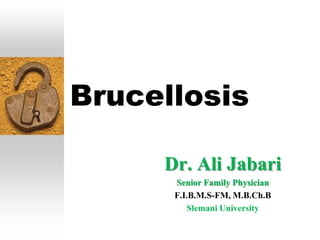Brucellosis by dr.ali jabari
- 1. Brucellosis Dr. Ali Jabari Senior Family Physician F.I.B.M.S-FM, M.B.Ch.B Slemani University
- 2. Identification Zoonotic world-wide highest incidence in the Mediterranean, ME and the tropics 500 000 new cases diagnosed per year. In humans, is a disease of protean manifestations biological terrorism.
- 3. Infectious agent • Brucella abortus • Brucella melitensis • Brucella suis • Brucella canis
- 4. Epidemiology In animals; chronic lifelong ïƒ infectious abortion and sterility. Infected animals ïƒ milk, urine, afterbirth. Occupational hazard ïƒ farmers, ranchers, veterinarians, abattoir workers, and laboratory personnel.
- 5. • incidence varies ïƒ _control in domestic animal _pasteurization • Common ïƒ SE, ME, the Indian subcontinent, Africa, and Central and South America. • Infection ; ingestion of unpasteurized milk products from foreign countries.
- 7. Mode of transmission contact with infected tissues, blood, urine, vaginal discharges, aborted animal fetuses and especially placentae. ingestion of raw milk and dairy products from infected animals. inhalation of aerosols accidental self-inoculation abrasions, cuts, conjunctiva. BM transplantation recently.
- 8. Incubation period varies from 5-60 days; occasionally several months.
- 9. Clinical features Systemic acute or insidious Subclinical and unrecognized infections fever Localised suppurative infections Osteoarticular complications Orchitis, epididymitis, osteomyelitis and endocarditis are less common.
- 10. CFR in untreated brucellosis is 2%, mostly due to endocarditis from B. melitensis infections. Arthritis may occur in relapse
- 11. Diagnosis Culture ïƒ blood, BM, other tissues or discharges. Serology combine a test (Rose Bengal and seroagglutination) detecting agglutinating antibodies (IgM, IgG and IgA) with others detecting nonagglutinating antibodies (Coombs-IgG or ELISA-IgG). Except in the case of B. canis, Ab to lipolysaccharide Ag.
- 12. Period of communicability There is no evidence of communicability from person to person.
- 13. Susceptibility & resistance Everyone is susceptible to infection. Severity and duration of clinical illness are subject to wide variation. Duration of acquired immunity is uncertain. People at risk are farmers, hunters, and eaters of unpasteurized cheeses or other unpasteurized dairy products.
- 14. Methods of control __Preventive measures: Educate the public, particularly travellers, Educate risky group Search for and Ix livestock at risk of infection. Segregation or slaughtering of infected herd. Animal vaccination
- 15. __Control of patients, contacts and immediate environment: Report to LHA Isolation Concurrent disinfection: purulent discharge. Quarantine: none. Immunization of contacts: none. Investigation of contacts and source of infection: contact tracing S&S
- 16. Specific treatment: a) D+R, or D+G or S for 6 weeks. b) TS+R children. c) meningitis or endocarditis, D+R+TS must be continued for months or years. d) Never use a single drug (high risk of relapse). e) Relapses occur in about 5% of patients treated with D and R; re-treat with original regimen.
- 17. Outbreak measures: Trace source of infection such as contaminated unpasteurised milk products and institute appropriate control measures. International measures: Control of domestic animals and animal products in international trade and transport


















